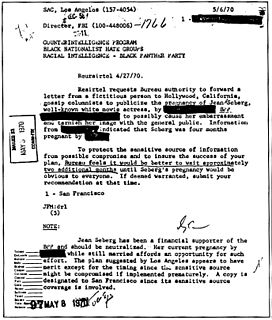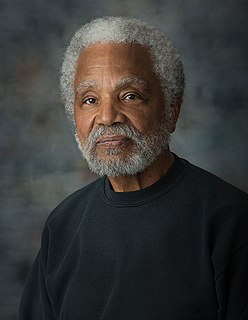Related Research Articles

COINTELPRO (1956–1971) was a series of covert and illegal projects actively conducted by the United States Federal Bureau of Investigation (FBI) aimed at surveilling, infiltrating, discrediting, and disrupting domestic American political organizations. FBI records show COINTELPRO resources targeted groups and individuals the FBI deemed subversive, including feminist organizations, the Communist Party USA, anti–Vietnam War organizers, activists of the civil rights movement and Black Power movement, environmentalist and animal rights organizations, the American Indian Movement (AIM), Chicano and Mexican-American groups like the Brown Berets and the United Farm Workers, independence movements, a variety of organizations that were part of the broader New Left, and far-right groups such as the Ku Klux Klan and the National States' Rights Party.

Fredrick Allen Hampton Sr. was an American activist. He came to prominence in Chicago as deputy chairman of the national Black Panther Party, and chair of the Illinois chapter. As a progressive African American, he founded the antiracist, anticlass Rainbow Coalition, a prominent multicultural political organization that initially included the Black Panthers, Young Patriots, and the Young Lords, and an alliance among major Chicago street gangs to help them end infighting and work for social change. A Marxist–Leninist, Hampton considered fascism the greatest threat, saying, "nothing is more important than stopping fascism, because fascism will stop us all.”

Ernest William Chambers is an American politician and civil rights activist who represented North Omaha's 11th District in the Nebraska State Legislature from 1971 to 2009 and again from 2013 to 2021. He could not run in 2020 due to term limits.

The Black Power movement was a social movement motivated by a desire for safety and self-sufficiency that was not available inside redlined African American neighborhoods. Black Power activists founded black-owned bookstores, food cooperatives, farms, media, printing presses, schools, clinics and ambulance services. The international impact of the movement includes the Black Power Revolution in Trinidad and Tobago.

The African Blood Brotherhood for African Liberation and Redemption (ABB) was a U.S. black liberation organization established in 1919 in New York City by journalist Cyril Briggs. The group was established as a propaganda organization built on the model of the secret society. The group's socialist orientation caught the attention of the fledgling American communist movement and the ABB soon evolved into a propaganda arm of the Communist Party of America. The group was terminated in the early 1920s.
David Rice and Edward Poindexter were charged and convicted of the murder of Omaha Police Officer Larry Minard. Minard died when a suitcase bomb containing dynamite exploded in a North Omaha home on August 17, 1970. Officer John Tess was also injured in the explosion. Rice died on March 11, 2016. He was 68 years old and had been in poor health.
US Organization, or Organization Us, is a Black nationalist group in the United States founded in 1965. It was established as a community organization by Hakim Jamal together with Maulana Karenga. It was a rival to the Black Panther Party in California. One of the early slogans was, "Anywhere we are US is." "US" referred to "[us] black people" in opposition to their perceived oppressors ("them").

North Omaha is a community area in Omaha, Nebraska, in the United States. It is bordered by Cuming and Dodge Streets on the south, Interstate 680 on the north, North 72nd Street on the west and the Missouri River and Carter Lake, Iowa on the east, as defined by the University of Nebraska at Omaha and the Omaha Chamber of Commerce.
This is a list of topics related to racism:
The civil rights movement in Omaha, Nebraska, has roots that extend back until at least 1912. With a history of racial tension that starts before the founding of the city, Omaha has been the home of numerous overt efforts related to securing civil rights for African Americans since at least the 1870s.
The timeline of racial tension in Omaha, Nebraska lists events in African-American history in Omaha. These included racial violence, but also include many firsts as the black community built its institutions. Omaha has been a major industrial city on the edge of what was a rural, agricultural state. It has attracted a more diverse population than the rest of the state. Its issues were common to other major industrial cities of the early 20th century, as it was a destination for 19th and 20th century European immigrants, and internal white and black migrants from the South in the Great Migration. Many early 20th-century conflicts arose out of labor struggles, postwar social tensions and economic problems, and hiring of later immigrants and black migrants as strikebreakers in the meatpacking and stockyard industries. Massive job losses starting in the 1960s with the restructuring of the railroad, stockyards and meatpacking industries contributed to economic and social problems for workers in the city.
Racial tension in Omaha, Nebraska occurred mostly because of the city's volatile mixture of high numbers of new immigrants from southern and eastern Europe and African-American migrants from the Deep South. While racial discrimination existed at several levels, the violent outbreaks were within working classes. Irish Americans, the largest and earliest immigrant group in the 19th century, established the first neighborhoods in South Omaha. All were attracted by new industrial jobs and most were from rural areas. There was competition among ethnic Irish, newer European immigrants, and African-American migrants from the South, for industrial jobs and housing. They all had difficulty adjusting to industrial demands, which were unmitigated by organized labor in the early years. Some of the early labor organizing resulted in increasing tensions between groups, as later arrivals to the city were used as strikebreakers. In Omaha as in other major cities, racial tension has erupted at times of social and economic strife, often taking the form of mob violence as different groups tried to assert power. Much of the early violence came out of labor struggles in early 20th century industries: between working class ethnic whites and immigrants, and blacks of the Great Migration. Meatpacking companies had used the latter for strikebreakers in 1917 as workers were trying to organize. As veterans returned from World War I, both groups competed for jobs. By the late 1930s, however, interracial teams worked together to organize the meatpacking industry under the United Packinghouse Workers of America (UPWA). Unlike the AFL and some other industrial unions in the CIO, UPWA was progressive. It used its power to help end segregation in restaurants and stores in Omaha, and supported the civil rights movement in the 1960s. Women labor organizers such as Tillie Olsen and Rowena Moore were active in the meatpacking industry in the 1930s and 1940s, respectively.
African Americans in Omaha, Nebraska are central to the development and growth of the 43rd largest city in the United States. The first free black settler in the city arrived in 1854, the year the city was incorporated. In 1894 black residents of Omaha organized the first fair in the United States for African-American exhibitors and attendees. The 2000 US Census recorded 51,910 African Americans as living in Omaha. In the 19th century, the growing city of Omaha attracted ambitious people making new lives, such as Dr. Matthew Ricketts and Silas Robbins. Dr. Ricketts was the first African American to graduate from a Nebraska college or university. Silas Robbins was the first African American to be admitted to the bar in Nebraska. In 1892 Dr. Ricketts was also the first African American to be elected to the Nebraska State Legislature. Ernie Chambers, an African-American barber from North Omaha's 11th District, became the longest serving state senator in Nebraska history in 2005 after serving in the unicameral for more than 35 years.
Crime in Omaha, Nebraska has varied widely, ranging from Omaha's early years as a frontier town with typically widespread gambling and prostitution, to civic expectation of higher standards as the city grew, and contemporary concerns about violent crimes related to gangs and dysfunctions of persistent unemployment, poverty and lack of education among some residents.

The Black Panther Party (BPP), originally the Black Panther Party for Self-Defense, was a Marxist-Leninist and black power political organization founded by college students Bobby Seale and Huey P. Newton in October 1966 in Oakland, California. The party was active in the United States between 1966 and 1982, with chapters in many major American cities, including San Francisco, New York, Chicago, Los Angeles, Seattle, and Philadelphia. They were also active in many prisons and had international chapters in Britain and Algeria. Upon its inception, the party's core practice was its open carry patrols ("copwatching") designed to challenge the excessive force and misconduct of the Oakland Police Department. From 1969 onward, the party created social programs, including the Free Breakfast for Children Programs, education programs, and community health clinics. The Black Panther Party advocated for class struggle, claiming to represent the proletarian vanguard.

The FBI Indexes, or Index List, was a system used to track American citizens and other people by the Federal Bureau of Investigation (FBI) before the adoption of computerized databases. The Index List was originally made of paper index cards, first compiled by J. Edgar Hoover at the Bureau of Investigations before he was appointed director of the FBI. The Index List was used to track U.S. citizens and others believed by the FBI to be dangerous to national security, and was subdivided into various divisions which generally were rated based on different classes of danger the subject was thought to represent.
The Ghetto Informant Program (GIP) was an intelligence-gathering operation run by the Federal Bureau of Investigation (FBI) from 1967–1973. Its official purpose was to collect information pertaining to riots and civil unrest. Through GIP, the FBI used more than 7000 people to infiltrate poor black communities in the United States.
Angie Dickerson was a New York-based tenants' rights organizer involved in the Communist Party, and was under surveillance by the FBI. She was one of the members of Sojourners for Truth and Justice, a leftist, black feminist organization formed in 1951.

On June 24, 1969, Vivian Strong, a 14-year-old African American girl, was killed in Omaha, Nebraska, United States, when a white police officer shot her in the back of the head without warning. The white police officer, and his Black partner, had been dispatched to the location because there were "juveniles breaking in." When they arrived at the scene a small group of teenagers fled out of an abandoned apartment where they had been dancing. The killing sparked three days of riots in Omaha's predominantly African-American Northeast neighborhood.
References
- ↑ United States Government Printing Office. (1971) United States Congressional Serial Set. p. 84.
- ↑ United States Congress. (1970) Black Panther Party: Hearings, Ninety-first Congress, Second Session. House Committee on Internal Security. p. 4887.
- ↑ United States Congress. (1970) Black Panther Party, Hearings. p. 4448.
- ↑ (n.d.) Distilled in Black and White Archived 2007-09-29 at the Wayback Machine Omaha Reader.
- ↑ A Guide to the Microfilm Edition of Federal Bureau of Investigation Surveillance Files - FBI Files on Black Extremist Organizations. Retrieved 12/20/07.